Dory

Dory is a student at Scripps College currently completing her research at Sandia National Laboratories under Dr. Hunter Knox.
Week 9 and 10
August 13th, 2018
As things wind down with my internship, I’ve started to put together my AGU poster (minus results because they don’t completely exist yet!) and starting new models as they finish. I also recently acquired yet another data set for this set of surveys, and it would be great to have this one picked and compiled with the other data I’ve analyzed before I leave, so I’ve been going into overdrive to pick and analyze this new data set and get models started before I lose access to the software!
I’ve also been having some great conversations with Hunter about moving forward after I leave Sandia, which is making me feel a lot better about extending my research into a senior thesis in the fall. This summer experience has given me so much more than I could have imagined, both in skills/practical experience as well as mentors and networking opportunities. I am beyond grateful for everything Hunter, and everyone else in the group, have helped me achieve in this short internship. I didn’t know a lot about my project coming in, but I think I’ve met many, if not all of my initial summer goals.
I’ve been thinking a lot about what comes after graduation, and as of right now I’ve decided not to apply to graduate schools during my senior year. I’m happy with the idea of doing another research internship next summer, and taking the fall after graduation to explore graduate programs and advisors and decide on what school/program is truly the best fit for me. My time at Sandia has shown me a whole set of career paths through national labs that I had never thought about before this summer, and I can easily see myself being happy and successful working in a national lab environment.
To close out my final blog post of the summer, here are some photos of my New Mexico experiences that I haven’t yet shared. Thanks for reading!







Sandia National Laboratories is a multimission laboratory managed and operated by National Technology and Engineering Solutions of Sandia LLC, a wholly owned subsidiary of Honeywell International Inc. for the U.S. Department of Energy’s National Nuclear Security Administration under contract DE-NA0003525.
Week 8
July 31st, 2018
After successfully creating preliminary p-wave velocity models, it’s time to expand and analyze the other data sets that were collected, specifically the data recorded in the monitoring holes during each of these surveys. I’m in kind of strange position now, trying to wind down and reflect on what I achieved this summer, while also still going full-speed on analyzing this new data set. This is a huge amount of data, so it’s unlikely I will finish analyzing it before the end of my internship. However, I got a good start this week. We ran into some more software problems when trying to pick the shear data, but hopefully that will be resolved next week. In the meantime, I’ve been refining my AGU abstract with feedback from my mentors.
Sydney and I went on a great mini road trip this weekend, and made it to White Sands as well as Carlsbad Caverns. It was a lot of car time (props to Sydney for driving!) but it was amazing to get to see White Sands at sunset, and spend a few hours out of the heat in the chilly caves of Carlsbad. I’m quickly running out of weekends here in New Mexico, so I’m so glad we finally made it down there!
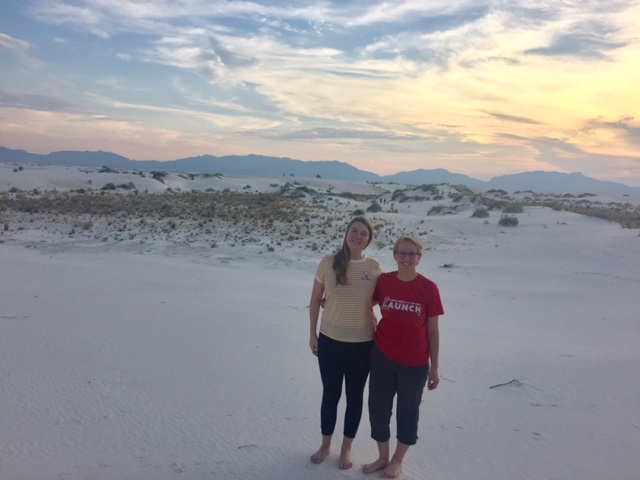
Sandia National Laboratories is a multimission laboratory managed and operated by National Technology and Engineering Solutions of Sandia LLC, a wholly owned subsidiary of Honeywell International Inc. for the U.S. Department of Energy’s National Nuclear Security Administration under contract DE-NA0003525.
Week 7
July 25th, 2018
After my week in the mine, we started to realize how little time I have left at Sandia, and tried to make a plan for what I should try to finish while I’m here. The group would really like to have P-wave and shear wave velocity models finalized, so we can calculate a value for the Young’s modulus of the rock using the velocity models and the density of the rock. Young’s modulus is a very important parameter for the rock mechanics group on this project to accurately model fracture propagation. We are close to having a p-wave velocity model, but this week I started to push forward on the shear data and did all the preprocessing that needs to be done before picks can be made. After many of the challenges and slow-downs I’ve faced so far this summer, it feels great to have a clear plan of where to go next and exactly what steps need to be taken to get there. I’m sure there will inevitably be more obstacles to overcome, but I’m now more prepared to deal with problems, both in my actual skills as well as having a positive attitude that it will work out in the end. And I’m not too worried about getting everything done in the next three weeks, because I’ll continue whatever needs to be finished in the fall as a part of my senior thesis!
Sandia National Laboratories is a multimission laboratory managed and operated by National Technology and Engineering Solutions of Sandia LLC, a wholly owned subsidiary of Honeywell International Inc. for the U.S. Department of Energy’s National Nuclear Security Administration under contract DE-NA0003525.
Week 6
July 25th, 2018
I just got back from my week in (or rather, below) Lead, SD. Other than a few travel hiccups and some very early mornings, the trip was an overwhelming success. Going a mile below the surface to the 4850 level of the Sanford Underground Research Facility (SURF) is an experience I will never forget. I had the opportunity to meet several of the scientists on this project from other national labs, and it was amazing to see the productivity and success of a collaboration between so many different individuals and institutions. Being at the site in person was very helpful in contextualizing the mental picture I had of the setup, and it was really cool to see the other types of tests happening as a part of the same project.
Waiting for our (12 minute!) cage ride down to the 4850.
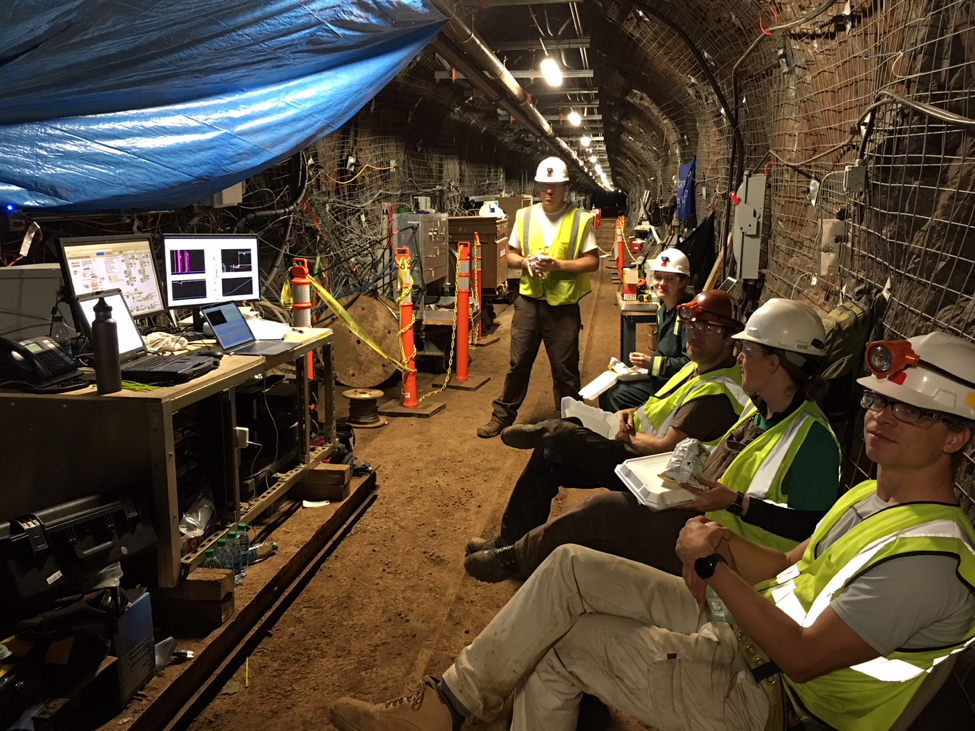
The crew enjoying lunch in the drift, watching data come in from the monitoring equipment in real time.
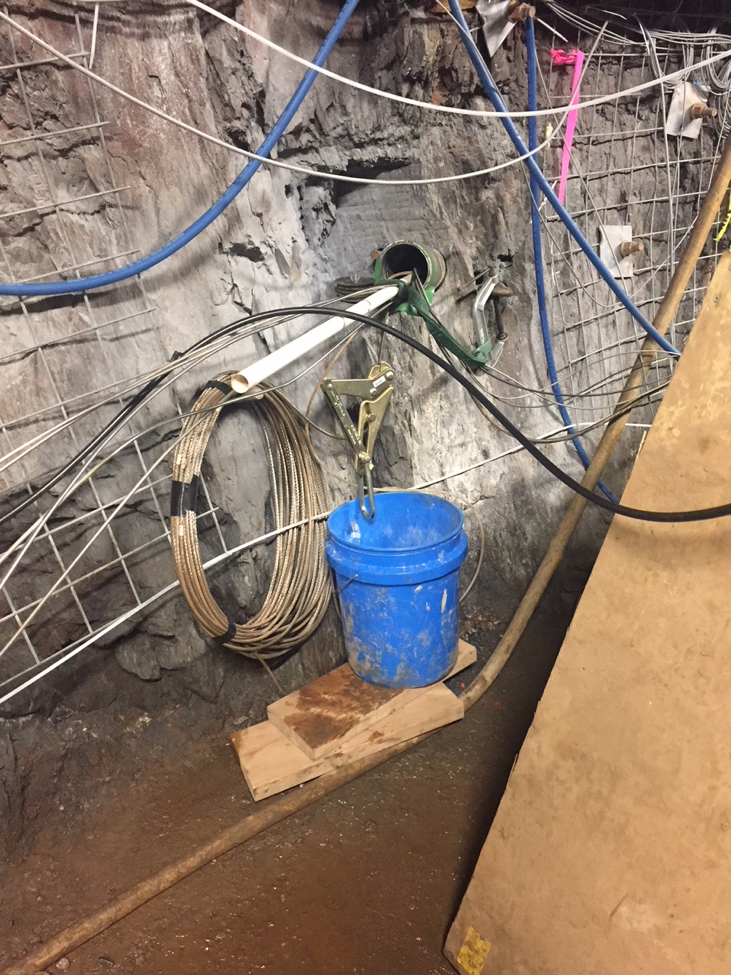
One of the boreholes where it intersects the drift. All of the cables and wires are for a slew of monitoring equipment.
Sandia National Laboratories is a multimission laboratory managed and operated by National Technology and Engineering Solutions of Sandia LLC, a wholly owned subsidiary of Honeywell International Inc. for the U.S. Department of Energy’s National Nuclear Security Administration under contract DE-NA0003525.
Week 5
July 25th, 2018
Get ready for a wave of blog posts! The week of the 4thof July was not as productive as I would have liked, given the day off in the middle of the week. However, I did manage to debug my model plotting code and start preparing for my week in the field in South Dakota. It’s hard to believe my time at Sandia is halfway over!
A paper that is central to my work this summer is “An Overview of the EGS Collab Project: Field Validation of Coupled Process Modeling of Fracturing and Fluid Flow at the Sanford Underground Research Facility, Lead, SD” by Kneafsey, et al. It provides an overview of the whole EGS Collab project, and has been very helpful in providing context and improving my understanding of the bigger picture of my work.
We finally have some decent velocity models! Below is a figure showing the 3D velocity model averaged over the ~15 m difference in the vertical component. The blue dots are the sources and the red dots are the receivers. The borehole labels on this figure are incorrect, but it shows the gist of the velocity structure. There is a natural fracture between the holes, and this may be represented by the transition zone visible in the velocity structure (diagonal green area). We need to do some more digging (no pun intended) to confirm this, but it’s pretty exciting to have a plausible velocity structure from my picks!
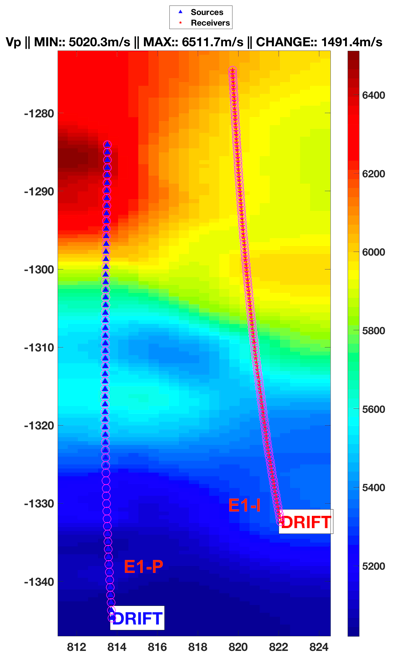
A map view of the velocity structure of the rock surrounding the boreholes, averaged over the vertical direction (about 15 meters of depth). For reference, this view is rotated 90 degrees clockwise from the hole configuration figure in last week’s post.
Week 4
July 17th, 2018
I've been out of town for fieldwork, so despite the posting date, this is for the last week of June.
This past week I’ve begun to feel a little frustrated and haven’t made a lot of progress. Once I had all the p-wave arrival picks finalized, it was time to invert them to create a three-dimensional velocity model. This is proving to be somewhat of an obstacle, as we have run into several problems along the way. We spent most of a day figuring out a functioning set of parameters to give to the modeling code that works for this data set, and I am still in the process of plotting the model output in a way that best allows us to see the velocity anomalies and improve the model. Hopefully my next post will have some beautiful 3D velocity models in it!
We were asked to create a map of our study area this week. My study area is a mile below the surface at the Sanford Underground Research Facility (SURF) in South Dakota, so I did my best to show the area with several maps. This map is a combination of images from Google Earth and graphics from SURF and an overview paper for this project that I have modified. This site was chosen for this stage of the EGS Collab project for a number of reasons, including its well characterized rock conditions, realistic stresses, and cost-effective monitoring. I also made a figure of the borehole layout in the mine.
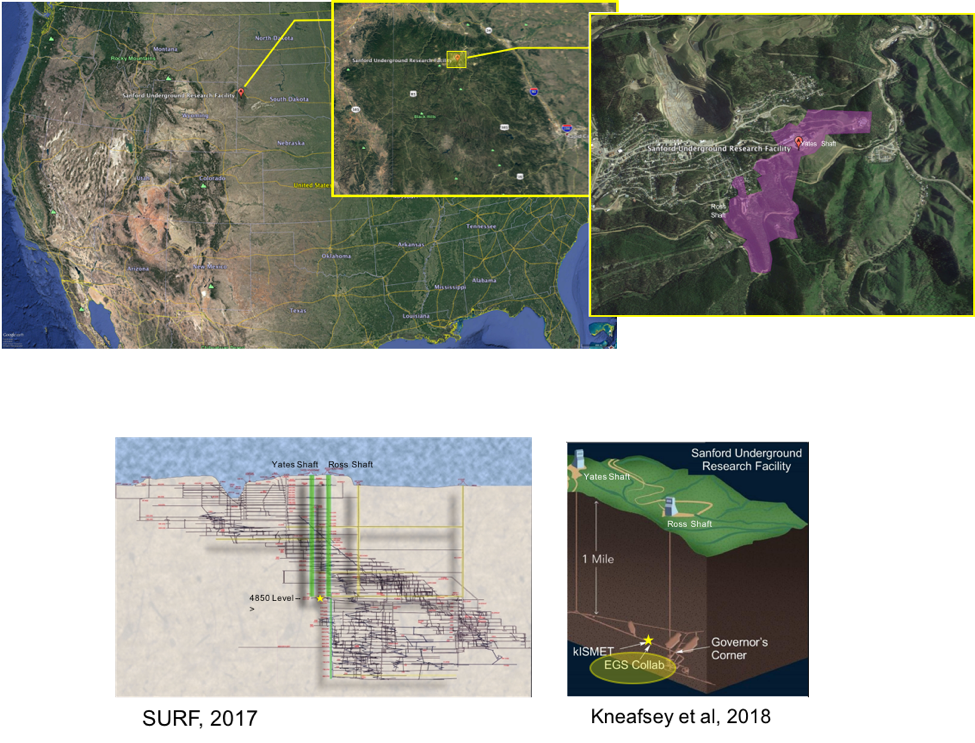
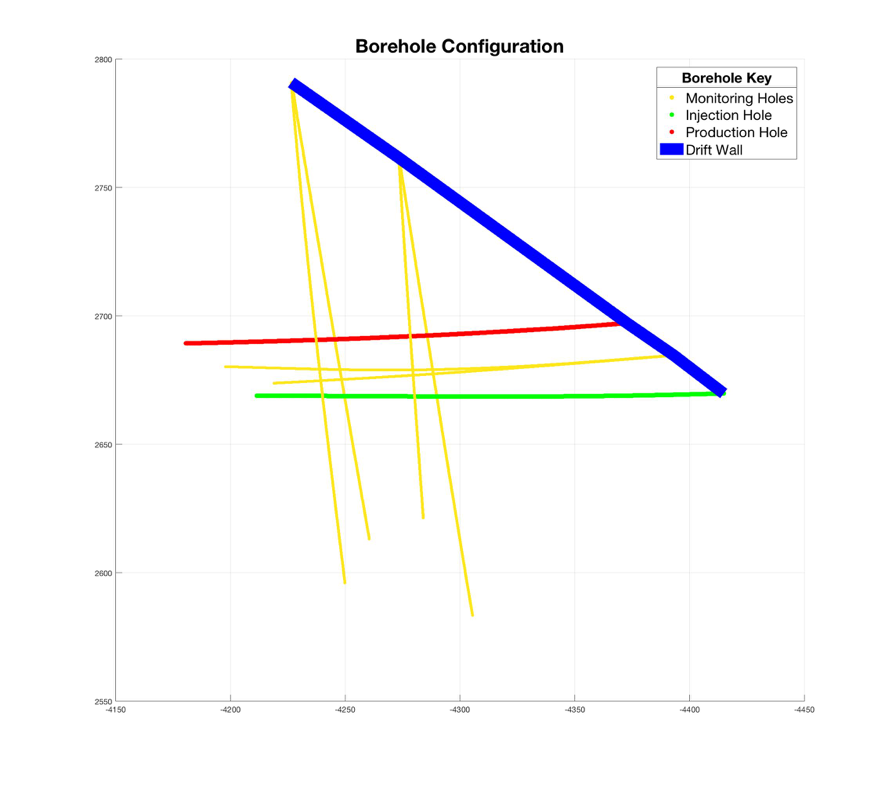
This weekend, I traveled to Oregon for a family reunion, which was fun and a necessary break from thinking about work. It was hard to leave after only a couple of days, but I am eager to get back to work and try to fix the issues I’m still facing.
Sandia National Laboratories is a multimission laboratory managed and operated by National Technology and Engineering Solutions of Sandia LLC, a wholly owned subsidiary of Honeywell International Inc. for the U.S. Department of Energy’s National Nuclear Security Administration under contract DE-NA0003525.
Weeks 2 and 3
June 25th, 2018
I'm still getting a hang of Sandia's review/approval process, so I got behind a week on posts!
Week 2 (6/11/18):
Since I was in the field all of last week, I really got started on my data analysis this week (after acquiring all of the software I needed and working out all of other the computer issues). The seismic data set I am working with was collected in April at the Sanford Underground Research Facility (SURF), and this week is the first time it has been looked at. These data were collected between a complex set of horizontal boreholes in the former mine, with the sources in one hole and the receivers in a parallel hole. The sources were also recorded on a permanently installed monitoring array. Because the data were completely raw and unprocessed, there were many steps we had to take to organize the data in a logical way for analysis. The program we are using for analysis is Seismic Processing Workshop (SPW), which has a bit of a learning curve due to its complexity.
Each shot depth (from 1 meter to 63 meters into the hole) corresponds to multiple laydowns (i.e. deployments) of the hydrophone array (because the line is only 24 meters long), so the data from each laydown had to be properly mapped and merged into 63 individual shot gathers, like the two examples shown below.

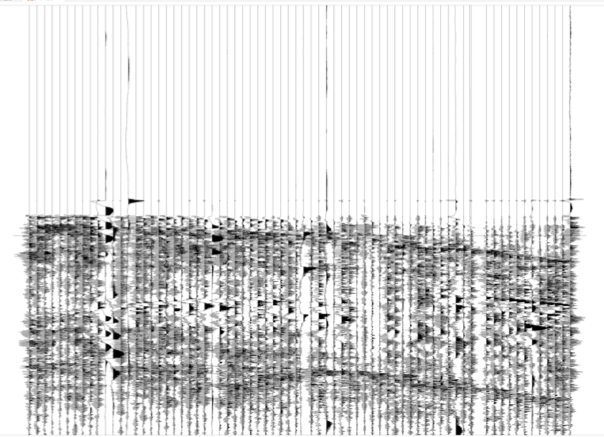
I helped construct a handful of MATLAB functions that organized the channels properly, killed the appropriate overlapping channels, added the borehole geometry to the data files, and displayed the data in SPW in a logical way.
The next step on the way to inverting the data and generating a velocity model is to make sure we constrain the timing of the shots well, as this is key to knowing the velocity. Since this method uses an electrical sparker source, an electromagnetic pulse (EMP) is generated upon source activation and recorded on the receivers nearly instantaneously (i.e. at the speed of light. This provides an accurate ‘time 0’ baseline from which the first seismic arrivals are measured. The EMP is visible as a faint horizontal line across the traces above. In order to shift all of the data so that the EMP is at time 0, I had to go through and pick the EMP times for all of the data, like the example below (amplitude is amplified to better see the EMP).

A skill that I am working to improve is tracking my own research progress. In past research, I haven’t maintained a research log, and I regretted it at the end of my research (especially months later at AGU) because I had already forgotten many of the early steps I had to complete in the first few weeks. I am on track to improve on this, because I have been jotting down what I accomplish each day.
I wanted to go camping this weekend, but it’s going to storm all day on Saturday. Instead, Sydney and I are planning on heading up to Santa Fe to visit Hannah and do all the indoor tourist-y things up there to make the most of the rainy day!
Week 3 (6/18/18):
This week, I learned how to pick p-wave first arrivals, and spent most of the week picking data. Sandia has a program for interns to see some of the work that is happening at the lab, so I got to go on a tour of an exhibit which highlights the big innovations that have come out of Sandia in recent years, which was cool to see. I’ve been here for three weeks and I am still constantly amazed at the resources and scale of the projects that are possible here.
Our assignment this week was to start working out an ‘elevator speech’ describing our research. This has definitely made me stop to think about what the big picture of my project is and how to convey it to a range of people. In addition to being used at AGU, I think that summarizing any research into a clear, concise description is an extremely valuable tool as a scientist. I don’t think a single elevator speech would be appropriate to give to all audiences, and it is important to tailor your message to the audience. For instance, I would give a much different explanation to other scientists in the field of geophysics than I would when describing my summer research to my grandma or to my friends who have limited science background. Because of this, instead of having a strictly scripted speech that I can recite to anyone, I have a good understanding of key information about the project that I can adjust to fit different audiences.
Outside of work, I have started exploring the area and getting to know New Mexico! Last weekend I visited Santa Fe and went to a couple cool museums, and I just went camping up in Bandelier national monument this past weekend with Hannah, which was absolutely beautiful! Here's a photo of us exploring the archelogical sites there.

Sandia National Laboratories is a multimission laboratory managed and operated by National Technology and Engineering Solutions of Sandia LLC, a wholly owned subsidiary of Honeywell International Inc. for the U.S. Department of Energy’s National Nuclear Security Administration under contract DE-NA0003525.
Orientation and Week 1
June 10th, 2018
It's been a whirlwind couple of weeks in New Mexico! Orientation week was a blast, and it was so nice to meet a group of such supportive and fun people. The days were long, but everything we did - from beginning coding to hiking at 10,000 feet - were fun and valuable experiences. I got a glimpse at life in New Mexico, and felt prepared to go on to work at Sandia National Labs for the rest of the summer.
After returning to Albuquerque from Socorro and getting settled in, on Monday I began the process of getting all the necessary badges and passes for work on the Kirtland Air Force Base, where Sandia is located. It is definitely a different kind of work environment than I have experienced before in university settings, but everyone I've met so far has been very kind and helpful in getting me oriented. The group that I will be working with this summer happened to be installing equipment this week for an experiment related to my project, so I got to go into the field the rest of the week and help with the installations. Being in New Mexico in the summer, it was nearly 100 degrees every day, which made the work difficult, but the other people in the group made it very enjoyable. It was a great way to get to know everyone outside the office setting, and it was easy to tell how positive the work dynamic is in the group and how well everyone gets along. I even got to meet people from other institutions and national labs who are participating in the project.
Even though I didn't get started on my individual part of the project last week, I know that being in the field was a valuable learning experience and will be relevant to my project in the coming weeks. This project is a collaboration of many individuals from institutions all over the country, and it is exciting to get to play a part in this larger research. My goal for the rest of the summer is to find a piece of this project that I can explore in the nine remaining weeks I have here at Sandia, and then dig into further in the fall and expand into my senior thesis. I will provide more specifics of my research when I really get started next week (and it's been approved for public knowledge)!
I'm also super excited to explore the Southwest! I've made a giant list of all the things I want to do and see on the weekends, and it's great that Sydney is also in Albuquerque, and Hannah is only an hour away in Los Alamos. I can't wait to get together and see all the natural beauty of this part of the country!
Sandia National Laboratories is a multimission laboratory managed and operated by National Technology and Engineering Solutions of Sandia LLC, a wholly owned subsidiary of Honeywell International Inc. for the U.S. Department of Energy’s National Nuclear Security Administration under contract DE-NA0003525.


